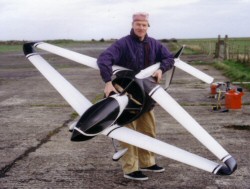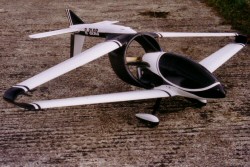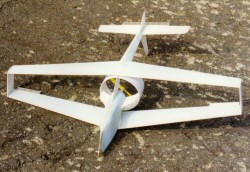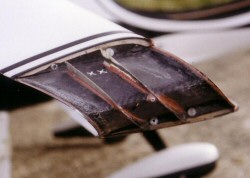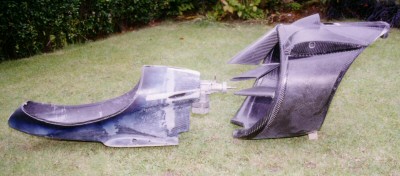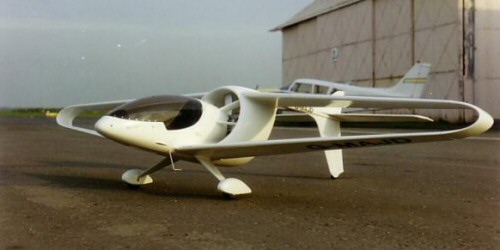|
|||
|
|
|
||
| View Shopping Cart |
| Home |
| Guides Available |
| About the Author |
| FAQs |
| Testimonials |
| Articles |
| Contact Andrew |
| Terms & Conditions |
| Mailing List |
| Links |
 |
 |
More high quality information absolutely free with every
Gibbs Guides newsletter. Sign up now!
White Diamond
An advanced microlight design concept
Part 3- Conclusions, hindsight, publicity and a large RC model
Article by Andrew Gibbs
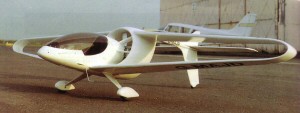
Conclusions
The project achieved its aims; I had a most satisfying time working on
this project, and I was delighted when the examiners chose to award me
a first class honours degree for my efforts.
With hindsight
Since completing this project more than two decades ago, I have continued
to be interested in aerodynamics and aircraft design, and I've come to
better appreciate the high level of skill, knowledge and experience necessary
to design a genuinely low drag aircraft - skills which I don't have! Nevertheless
I still feel the design concept is of interest, although if I were playing
at being an amateur designer/aerodynamicist a second time around I'd almost
certainly pursue different design concepts. If however I were to stick
with this particular concept, I'd reconsider the following aspects of
the design:
a) The wing tips could be changed to a flat plate design which would be cheaper to make. These might also work better in both aerodynamic and structural terms.
b) The wings might be better designed as folding rather than removable structures, making assembly easier.
c) The aspect ratio of the wings could be reduced, making for a more compact airframe and easier assembly.
d) The aspect ratio of the tailplane should be reduced.
e) Consideration should also be given to giving the tailplane anhedral so that it would be in the fan wash, making the elevator response more similar to conventional aircraft, which would add to safety.
f) Rotax engines have become much more reliable over the years, so I would very likely choose one of these today. To reduce drag, a cowling should enclose any exposed engine parts such as cylinder heads to reduce drag. As it stands, the existing air-cooled uncowled engine would be a source of high drag.
g) A wire brace could usefully run from the base of the fan duct to the tip of the fin. For a minimal weight and drag penalty, this would greatly reduce stresses on the boom caused by taxiing on rough ground.
h) As presently designed, the tail wheel would possibly make ground contact first on landing. To solve this problem, the fin could be a little shorter.
i) The region where the trailing edge of the lower wing and the forward face of the intake duct meet form an acute angle, which would probably generate an area of high drag. This could probably be resolved using a curved fairing with a design similar to that used to blend the fuselage/trailing edge junction on a number of WW2 fighters e.g. Spitfire.
j) The shape of the fuselage, particularly the aft portion, could be reshaped to achieve a lower drag.
Publicity
At the conclusion of the project, it was displayed at an end-of-year exhibition.
As a result of this, it gained plenty of publicity and further exposure.
For example, it was selected for exhibition at the Design Centre, London.
The project also went to a design exhibition in Japan.
Several magazines featured the project; it appeared prominently in Design magazine and Engineering magazine and Flight International both had pieces about White Diamond.
A large RC model
In 1995 a three-page article about the design appeared in Popular
Flying, the Popular Flying Association's magazine (now Light Aircraft
Association). This led to Dr Liam Scott contacting me and asking for permission
to build a large model.
Accordingly, I provided drawings and Dr Scott set to work at his home in Ireland. One of his first tasks was to build a small powered (0.049cu in/0.8cc engine) proving model. This flew well and encouraged him to begin his large Super Tigre 3000 powered example.
At this time, I was enjoying my first ever paid employment as a pilot, flying a Cessna 207 on survey missions while trying to pay off my considerable flying debts. One evening it so happened that my employer had me staying overnight in a hotel in Ireland. Grabbing the opportunity, I hitch-hiked two hours to meet Dr Scott, discussed and photographed his fine work and then I hitch-hiked back to my hotel, arrriving just in time for a short night of sleep before getting back to flying the next day!
Dr Liam Scott built
this 104inch span, 23lb RC model of my design. His
workmanship was of outstandingly high quality. |
|
Dr Scott started his
project by building this small powered proving model. It flew well,
and encouraged him to build his large all-moulded model. |
|
|
Dr Scott's work was of astonishingly
high quality. All of these components have been expertly moulded
from carbon fibre. |
The model was large and very beautifully built from moulded carbon fibre components. Dr Scott kindly sent me a video of the model flying. He reported that it flew well, but exhibited a minor pitch stability issue. Unfortunately I never witnessed the model flying as it crashed after suffering an elevator failure before I could travel again to Ireland. It is unknown whether this failure was connected in any way to the pitch stability issue.
|
This realistic shot of White
Diamond has caused many to ask if a full size prototype was built.
One day, perhaps....... |
